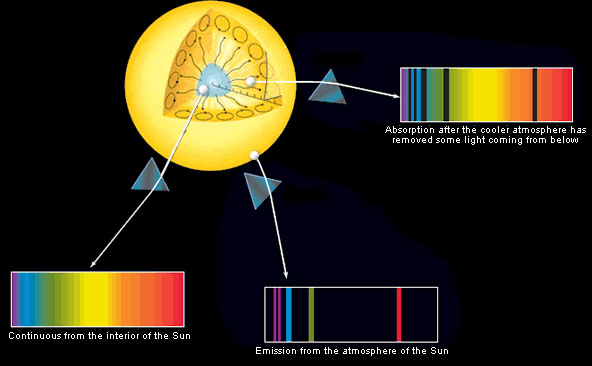Chapter 5. Spectra and Kirchhoff's Laws
5.1 Introduction
Author: Beth Hufnagel, Anne Arundel Community College
Editor: Grace L. Deming, University Of Maryland
The goals of this module: After completing this exercise, you should be able to:
- Recognize that an object's temperature and density can be inferred from the amount and type of light it emits.
- Use Wien's Law to quantify how hotter, dense objects (such as stars) emit more short wavelength light than cooler, dense objects (such as planets).
- Use the Stefan-Boltzmann Law to quantify that hotter dense objects emit more energy per square meter of surface area per second than cooler dense objects.
- Infer the density and temperature of an object from its spectrum.
In this module you will explore:
- How an object's temperature affects the light it emits and absorbs.
- How an object's density affects the light it emits and absorbs.
Why you are doing it: By understanding that an object's temperature can be revealed by studying the light that it emits, you can learn how astronomers are able to determine the temperature of distant celestial objects, whether hot or cold. In addition, the light coming from distant objects gives clues to the density of the material emitting or absorbing the light.
5.2 Background
The simplest and most common way to produce light, either on or off the Earth, is to heat material. Use this animation to explore what happens when electrical energy is added to a neon light bulb. Add neon to the tube, then see what happens when you change the temperature dial. The horizontal axis of the spectrum is in nanometers (nm). Clear the spectrum and Open the periodic table to add a different element. Are the elements the same or does each have a unique pattern?
Question Sequence
Question 5.1
q99UWb4zm5tUG735oXOePkq65TJx2QbnuW49Bf9gv4gyKNSj1q5yusdQJuL4m3+XvG1Im8j2wRA1qqn8gKD2hp1w+RwkrP6Hy6i0F+DIfbXYdyOiP9bnREn3x+M7D9IYunR1cHgzHzUjNWOCyP5nqmPFPn1NbNrLqZqVqCb22e7zsxSRYVRHY7q619/QWPTRwyp/0VopqMUu2YaBX3JjK2c/PRyQs4/Wae2uonu5WlNG3t9IUA54XyZwRKELz0/19DUuv9YAbsYuiRU9fnk+5ya1+ZAQFCE5F7Z6I9ZZI7chOIYJBfmnVf2Beh5uNzlT6kpCFFM9lEPb36eMZcOH5bSeiK2xPrR4Pwuui5oAbRr0dJ8ogKESy8Ad3QFv5qNobXrE4MGUWs2VRxPGQuestion 5.2
47cSKgvpj6Vktr51UsT5/nf/94qyTaD1cPLChhUiBVe9zOlXor8wAX5f82xZv60rldQldgLfHtb6j0Hy7yyx61bNY8C2RAZS0FRsZU5+zDOuhrJlx+wItqHF65qT+3Mf//fXFulORXHof1zj82glhcWiZKDqu0BaARdh+PVlQg9T8smtwUqBt5m07heUW0jVYCzS8fEQ1LKmQoy2PQZDnwKKsRQb1PM/oMvYOrXxREh9HwveqOMSsXntL8kdKd2PZtYfig==Question 5.3
Qsr7lbU42Y6XlUSW+z7GAL1zI+weM+YngTJ9TJy90cNCCo0RYZS945ZAxU4eqj/y2uVpp3IWTLuKnXRU1FBmRe/4gWcmY8nhk9SIL4exxIZIfTc4Jlo0/FkJzmqxS9gqUEDwu1DCLTB0bnLXCgWbvbAPIXAuMvpMWFovGGUJjfCuYtUWhFmJKHhrlk8tsmMYFqufP5dJi3wZ4hZb+srD7ZlvhMuzbnTUCeq5Pwe2MrfAK286Lpdoyge4RBpclbM2jkq162oOryN11d2g3W4BphKjbtY2h+zCcyjq4jVFfWsy9ir1ImudhdEIF5oCrDXDDli2LpU+PsKAv6UgFCvZvVmiF9IlpmTCz7MrLU8FtSHvQLQphp8zOFpbBOO9bUZuGUeM9XpI4PlT0rhM5D31TQDqz3jpVJd8h9vgBUKqRWYltER2jPt4PZDF5oe9d1yAqEF6PeafLLkIAn3/bVb1hvyerknV4++TaOSW4COHLbrvFtO1lWi548RGbrgikKwK926GWbj9rWG8XoPmx1kOIF1IYkCt2/Mc5dTeSGhhCzhb1xtjGDwHJw==5.3 Kirchoff's Second Law
So far, spectra have been represented as a bar of visible light. The color is on the horizontal axis, with the red to the right and blue to the left. Intensity has been represented by how bright the color is. Spectra produced from modern digital cameras also have the colors on the horizontal axis, but labeled with their wavelength in nanometers. The intensity is shown by the height of the vertical axis. The emission spectrum of neon would transform as shown below. Click on several elements in the periodic table and take a look at their spectra as well.
Question 5.4
eyghGG8YNYM/R83LOxb+9593aasTzbIkmC1mgMT1VRbBODDqKiEuahRMV4lAQOQpaDIThZpH045OVwVgahqh3tq0DMsemM5PNO4g28c/gtuyn4UBK9wDvW7u9EZdKewrDOro9UycGF0hq1iA/D/CWqq1OHZ0kfjpjvOCiclI/fCreXJeUGM1Ee1Fh2d58fXBD6Brz+OCKKhCXG9Sg1sU1TYFxawpCupa3Vg418fSYCJivy0j2fztAMhtidZvJFa9/nLDJwdLc7Y3/2Tp3DegbhjmqY0qM6i3LgBhXlfxNG35BWrqd7Y3klalAhEHyRSOdqza5IcP7ViW/xy+kJ0FB6aVk94JEVh3ICQfS5+NgDZM4x3xLQwMpwcO28v/ZKan5.4 Wien's Law and the Stefan-Boltzmann Law
The color of light radiated by the Sun, other stars, and planets is also dependent on their temperature because the intensity of each line changes as the temperature increases.
These celestial objects are also so dense that you can't see through them, and light is trapped inside them and can only escape at the surface. The continuous spectrum that results is described by Kirchhoff's First Law: A hot, opaque body such as a hot, dense gas produces a continuous spectrum - a complete rainbow of colors without any spectral lines.
This also means that the light that does get out can be modeled by two equations, Wien's law and the Stefan-Boltzmann law.
Use this animation to explore how changing the temperature changes the color and intensity of the light.
This is quantified in Wien's law, \(\lambda_{max} = \frac{0.0029•K•m}{T}\)
Question Sequence
Question 5.5
O5Bs2JRVfc+c84k6c2sSMx7gXm0hLfodATMeDaxM9+h2jEaI4jLBXz6ycbHhBrVKIFJ4w55YSKye7Jji1ihUbiI94NnYRIhqju2iRL4srdeRrJMyIVqR2W2JSg4yK0u88hUo3sLiPq9WsYDRFKFziCaQi0BaNT+FBSUoA1wEb06vFQpdrNNDUSXY/SqN0s5tXg0Ro0qVrL8To5/cOlbilP0lR4zedtGVhV3dRWGZfj7UGaZ1BvgFcSAv/92fChythEr4iPAuV9oE+Qh2B9ovXRjlVgCvChZuooGfUHDER4cMtMqlupfWErWigPz++OWaMBuyGd9wVkU=Question 5.6
JFVHiFKqAZrdkB4ASudmSStScCL3fEVF8D2a0LfZrUf6c2QRA9OyNlxyOwssckGGIOLS+8Yn3MoSsJ9ygEFhefCzerZlDIygHyAFsyj7ErJxMbdrKx2ZCdWZCMwYrdZx5WBdu1KV6npwh3bFwb6uT3Jty1l2lPlZjBaC53vFPSXxd8aD/zJ3XxFJ06F7v8rI4EnpibwtBSLPH1cY0OrAkj7hclFNVsQJPBnk2Uc5hFB9M4H7p20GRa9a2aed4fl7WnYeFnK4cWjvwShqE0itXbdCwliDH0tcL4AVvdxiBN+73kvLCB+S6XX3r/aRm/kIgyh6szT+o2+S7hn9Question 5.7
HJf6mGEsBLzCc9GV18UfH/Uk6hEnYY+4wK9/oTaE755dVm1kFzifi0VULKXXULeYLY1Gtbzp/qV91qwO4Ow1IdNWFX8/L4dnzqTN4PMBlLCOrLDPF3lTOw6+bQq8QDelMlzntdGv4SRkMhxJiajLirR6A14ooem7fiB8wG9cVc1JapaIrj6jv/I9bwI1bgMUn27BtqRuHDYwINZdJhbqdsSSCaWq6jE0KmrTgT8Zv/jAlnUbs1Cnd9qr4dvgyTqf3CSoILtBlNxCKmscQuestion 5.8
MGuQ+NPtmMUqimwXe3nHKfOHE/teDoDLMTbvaF2jGT/YtxOxK0we06ja/C3RmJKVTy9Q4ANcWOGcMbBmKD1XcdVGrRMm+7cKGjTmf76ynL3Iz4/l3jURmA+6/F/lYjJJcuYwjW4SgShy+vXSjvm8fFDtfA4gOuOW1JlucjyCxC/0N4DHp0/8gNrm3GzjCw3nWrmcZjjNH0l8okNW79QOPdQ+ndYPseUhH6Jg+OqumZSq3NJtbMUrcwCnC/teJ602w3TGqkAwybunepHoJGV8a+6cNNkV2inGqDyvDrOVNDkttJihio/4o5sXD1Sj8EjEXBr1FhN+94zzxfxc577040QjULGROzS5e8IuwUZFBluiEFPaddkhL28QY9qWOO/wtyzzNgdKoIdH2gArl9WX987fAt/cSKTKZhRcVXHlUDDAP+uu6DAfD0ZtZ3AwSf9719rDJC8oOeE/3KJZ8OopqhZh3PZYh26oC7g6zWF/ziv0jHHs4nUVGqkxVKOvt59KJorh7gnTIWmCUToXxAL6w4uZyt0P8G7ItffsC/CpjaPbJqqj4G+j5T5nblYpdqXE5Q/FqunYb2EWlkq5tirfWpKrwOESEe05Pp8zMnOlrtcGANs4DVvItxdSqjI+wem+EbJhTDLZJb6F4jtPK+8tqMKH/uBgB9JH1LuhWla3T23s3/bdmOMYITU2WLzi+9cb9/PEzOpeYi7ozLNXq2OurQKX3K0eyqJ0WyWt7VZ0wkBtr02r8pvA0greEJ+FTtYEpS22WQsKTXOdfAHu+jBbgrYkuo5YeYWRQuestion 5.9
9Nh/YERFtWd+Pyzr5V68fPnWtIk9Mj/H8xSMhgpARGNlJRs7i3cxxgWysNbKqcQ3qexhokJjq5T2VcYW6zts+xxtQXDApmD375x8XuNvNBJUuelMWu5hAmytGpMT7IFW/3oL3VMTMTke1w61ixAGIdbkY+Me9HS03sNn84TwAW47GYXBJMhzjzBXxEHP7RReLoSgxpqnjdStu/5KZXU2gA==Question 5.10
meLGng0CrhVklFGeVhpUnIhSkQ5rrP3DiEyyzuKWTy5PyFdneru0DsXB8hyIZA5dbNdG42Q3sX6VCRlpJ9tbSnn1fRFAGE3Q/12KMG5vD/RlHNv5yJ33gvjNtjxe1DkD5udEz4naFo3qlW9WP4FF+kj3MUwU1GS9/QvIwLeN8c0IrudrmsqFNyRxFPQ=5.5 Kirchoff's Third Law
Stars are the only celestial objects that are described well by Kirchoff's first law. However, most stars also have a cooler, thinner atmosphere (called the photosphere) through which the light from the star must pass to get out and radiate away into space. Since that layer is cooler than the underlying layer (but still hot at 5800K!), the photosphere absorbs selected colors of light rather than emitting them. The resulting 'dark-line' or absorption spectrum is described by Kirchoff's third Law, which says that a cool, transparent gas in front of a source of a continuous spectrum produces an absorption line spectrum-a series of dark spectral lines among the colors of the continous spectrum. Furthermore, the dark lines in the absorption spectrum of a particular gas occur at exactly the same wavelengths as the bright lines in the emission spectrum of that same cool gas.

Question Sequence
Question 5.11
RiiukfYTsMHnxqhX1Ci27hbRDeD4c7Gd/zHrx/ydX/7BUdb2xdRqSgCdQHSnWwI1fFFBId6oQG/jNEOSJGNkPUk2yMneXTDE7guCpvyRr2zAHGeSN3qkLB2Jn0rvqdMH09QnR2b7ti+tc0D9t4YEj2s+4CpN0/s/WYg45HuLQ5y3YOWEmw4seSz1vwIP9Wtg/34TXVBdJkqgUu8l0hqb4OdmRDsowQT3C2LzSCd7POHKplW0OXe1qFg6FZsvCq43MmKmlxM+IFC3Z3GMep4lak3kfguF+ES676u368Znamg4fNtfDhMcYb5CBLLNJEWdXPwVKgLyDQI5Maow6djcyklLvi5zbT96dssBuSzeTxWiVuUPBWUt5tzv+9scdS0bs5OZJdj1prntbfor5yy/tKDTTgjqvTgpxfjsfjFV1vCPYOeC0Pi9+LKEEejEqo/UopJ9MY3/CrnNd48VWSPAsYmN0eI3d/OKIaURX+Trg/7m9cjnQJ65QBa5FAfr5teOrJeIHaV/Uujfum6L10SvkxDVf//nm+rk2/+RyxNQGRhrh0nKjNL9o2I3EoN8d+yf9tTy2IPuEyMorMmOB+6kd9oIRaU=Question 5.12
TiQfaarwRpA7zvp+tl0cghqhHilKb+9t06etC0YZUa1+7BiDOYxGoggHDWKMb8fAxEYC4Qi2cnH4M6FjFJfNoJQPyyywqc2rFzc15t3WcEHFFIMRelL8HoQbEI5CJGrMonAZbCDohYVD5sLPytnE4MVkY52YdvcDo9J9XDRNUIbho7B3jKYSeDuMkcqGU+3HOsJtjX9JzJCH4tLe3W8syReoQRew6oqBqWyD497cwtNTY56i83u4bvLhpf1zFrZzw4PVYfdwn4BuqLmTvZBYDEILoKBnnhYwspr01FyUtNYLz1j+GJF6awjKM08+umt5JoPYe+uTuKHN3H7GOowJXbG3v6z/SVAH7RutaZNgQ7T3Pvsu3hw7xB4Tikr/XPgXJxv948qKf+YZM60Xo8DvLuFflTpYmOw3gxznHL+MYHl+ceXQnao8W+9uD3fvwldVXgSRchqbxZh0AOu9NO4qau9BjvTcGkip5.6 Review of Kirchoff's Laws
Thin clouds of gas and dust described by Kirchoff's second law occupy the space between the stars, but have also been observed between galaxies. When we look at even the closest stars, there are thin clouds of interstellar gas and dust between us and the other star. Most of the time these clouds are cooler than the star, meaning that the light that arrives at our telescopes includes dark lines from both the star's atmosphere and from the gas and dust clouds. The cooler material absorbs some of the light from the star. The resulting spectrum is also described by Kirchoff's third law.
Question Sequence
Question 5.13
Can you label the spectra properly?

|

|

|
| iM3C1g6TPQhzsd9E6cdJ9dbIzHPYe7npZIXfcwlO/Mb2Nun8pI3KV4bdwHmOt0iu | Og1VuTAlG0ands8h2zFhwG7hiPg76w9x3H3hcwzMtKR+896g4Iyq47YShowRrZ3a | xx15AqpkWyqz/p3+i0BoM0x6pIEAwC8hnhdHWAU9+NHE2uklQlfNTrEbOveUN2VU |
5.7 Quick Check Quiz
Indepth Activity: Spectra and Kirchhoff's Laws
Question 5.14
JxXpW4eLuyD+mU43dZ0BNm3HI5kYxDX9Kva8dJNfM2vEJczIdg6Kqs5sQDu6tF9Cr2j1ifp3jowmof7nyCejMAzB8Q10H5dAB8x5CegEOM9MVZh1xgebddS892eX97fd9vzw+bpqgcOMSP9kkdFGHGQT77PD8K9ME8/AqYecByRvK9XEzThtHYDhbWX+w3gohiNvJpfih09FI1T4v1SQnZwpvyDNBK6acQIGp3GdxQiFj/wGhpiv/1FD/teAxa4psFlKSgcnoDXKERo1o2ESPM/bCMcLpTbGM0luThr9Zj8DbB7woJhyHvV0mE89bvg1Xe2tH62S63R2YjOZW/PgHl144GFxutfVuCDKvl3cOHHSOC9MQuestion 5.15
aBYT7THsNV4WMBsTbI4f1R213M4CRFYgvCoDot59fM9o/8SFp26uYd45NhZ9YW0PmzTWGX8+DvIinHH4TEDt6k/HVsJU5yMsCgH4c2sW40OgJyTM7a6eaiR9QHYoulWVvswxFxpVcf1YulpMjXnQkD1hwrgIBnFx11oSbH9yZr0gcNkKXJs0PTk7sRwBD52IZWdMBxDBbSaVi/DXcNIZ9OmGhowCxEtrIdr/F0QgdD+np0rLp4EwnKES89rHdMrOpc0OKKLUtezhFnq8a5HD3g==Question 5.16
ZL550Y8UHsY8fqxXcVNPTrX9P/2Zom51P5GKCFwprUc5/h2k/HMh5reFeyesvSdIlUxrkFLv3t2tp8SUhyWiTPEr/51b8U8UhdmRf2qsToz3I8JeiLMpWEOe0S1wOU991SxP2I/SS/rZW+Tb++TI+bQZyFk008UID4bWeetbQsNlldl9MY5PppjW4hR2m6jMtcrB4Y90HAsKiyxMzlQZIasidBSyk2mVFrja9eJ4pGyxnS2K5VR12iGpZYdlLBfLUxPAwcptbG+nyXnABnN/4eXUkosi4y7zQuestion 5.17
EfjpTOVHueJVubGVME0lEBZi9NXKHxeUCdZ9NfrEenz8cb5aoLRXjFbYCumJZFal0z1k2uAAWssqXtdcIXbp+eu7Fgfv6LCfxTZ5cpMjt73EF9kC7f66F4ipMCMz+d4KWcfsQLisc93opLezVgzdpB4hh6Uy818xvnQBWpcXo+KWLcc2K0/3U3tXfXztqhNOxqAOmSuDDghQ5P34Z7PIyNoh6Kf1nPpbZCH1jXbIdNXHN1OLln8Q/xsqYDdlzXTRbLiA04OXAvXZKpuSiJYQn1Ea1pPYMeK2BM+CXS7ODRsaETJ7mqIIoEEi6KIW+xpNDzxhq/mmhlKpVxNqj3COaTaMquUSdnK4ripZAgvgLrHduRy6CLrt7drDhEoNOAu/goE8jXEwVq0Kl458BobYuDyUww86KGxLUNRoD51OO3H4bacg2lp1WgPUqMjcKi5jdorCZjvQHk0=Question 5.18
mqyfIQMr82f4JQltiooiq5NdQgvaFXcYyOywlqlf3MsncE2m4A0noFS28rQWJKFgF12E/sSVnDFCbsmGL5o7XIDi1f0ymrBr33wcXlrGxXvfXsOOnKgieJOeejfAT0AsljcRVmUCEKaJXQi6x4NQQySQYia26rSIPF4yRb93pVB+k0t5wbPD70ZBcRsXx1ODwb86vN/JbXic76o5/jVgJvC24lT5lMwvpIPl4RwQLLlEILE2flDZ+jCIpEU=Question 5.19
MWJbIBrG1OYVXd5fsvZZnUtywctVFVRDnZIxDx/YilKbmlnEIbBivRrcvn1eRIKvYVDo0mjKDC0N5VfOGW0MKfVJIC/mzHGNwkU+n2g57iRGzOTBTk4kdG+RAoOyYvBAdAwZ9SXL4Phr44qsCtUV//z0S8blQDaMHlOlDpM5y5P/p5Es+rNiyUD1TIuGu2vym5Je08WW7cVcynm+sUObRiNVRo1SLtbMz4UklZJ73mBcW47uQuEkx1qvdEhtOWcgGLC2Syy5kOQQzcuBR9SGTuw2xxijvwSE1ZGMTQ==Question 5.20
rlnQkeAQrVcucMIbvidgWZ/sAUKf+DMm1gh/MZKhbK3tkpvHf5pTr/zlDy9USj5kf5FkFvvNih05lN9sMg7m6z6YWsvWx+uJlcpHCVoBLzBkTbTXYZWK8k1KpewEbyg+tVntQQjUJku8fmmpNLgYiwd9OnMrpwauaTtW/832O7qdm9gopp0dVZpTmHtiPglm0Y5mva2wMV1DRoVDyIw19PqLwJ5xWZK1Qylo4VmdvqvfCF0vq6HDuM4i+6LFJvq7MEIiney5/F/R0qYGG+EU5DpHPn7f5+SfG65GZ/YCZCUcRlOv8imGBG9cCnogPNECFvnwAZVz1IA+Dy9bp5nMhYL5vjws7bd36iFeJ9D/9Gke7ffaiEHCR0yuiaVOzmqE8dRk8nBTm2TdfyBUjTZEjvMRHhiIx3s/KXAqMbyqmLaR4uqGQtgqSjHOQRovLGUCnY2zPFjnXYg+xG7O6q2Yo94QpCKth4Zqrs4kHXqONfM4+iQslmnCzoZXDgicC8hraynS8VjoTLp7vdsZPa4KGMpBIYOJZvTChqnhvaAk4XNzKSrmj8QObB/teBYqzpogw/13E8yEZrteZRx4PUk8rBPmW6k0PEBfuu7zBlFlzlXvx0D0Daj5em4gQ6nRAoYhGLUgUEi50fUEsuVprxQQF+TLv245B5Jn1V2TAXsxAKjcjHtLSABNDu0RaLVRDOaszoTcC1X/C9a3A+AKO7MNnaq83ko4JAE6Question 5.21
